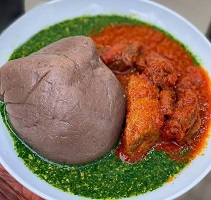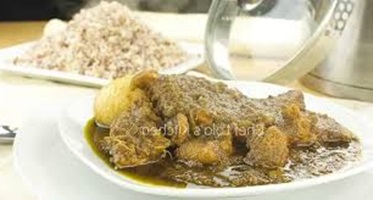Amala Nigerian Swallow Recipe
Amala Nigerian Swallow Recipe. Please Watch >>>>
When traditional food is wonderful, you usually want other people to taste it as well.
This is the reason I’m sharing with you in this post about the Amala Nigerian Swallow, a treat that has always been a staple of Yoruba cuisine.
Related Topics on Amala Nigerian Swallow
- amala-African-food-yam-flour-brown-amala-food-recipe/
- Nigerian-amala-food-recipe-how-to-cook-amala-ewedu/
- amala-how-to-make-lump-free-and-fluffy-amala-recipe/
- amala-food-nutritional-values-health-benefits-health-risk/
- amala-food-how-to-prepare-amala-dark-brown-yam-flour/
Amala Nigerian Swallow ~ What is Amala?
In the western parts of the nation, the Yoruba ethnic group consumes amala, a traditional Nigerian dish.
Unripe plantain, yam, and/or cassava flour are used in its production.
It’s challenging to visit any of the neighborhood bukkas in Lagos or Ibadan without running into this meal, as it’s a well-known Nigerian delicacy.

This Yoruba specialty is quick and simple to prepare, which is wonderful, but if you’re not cautious, you could get lumps that make it unpleasant to eat. Relax if you have trouble producing lump-free, fluffy, smooth amala; with this recipe, you’ll have it under control.
What are Swallow Foods?
Like American mashed potatoes, but with more texture, swallow foods are malleable but hard doughy dishes.
Pounded yam, eba, amala, starch, fufu, and several more items are examples from Nigeria.
The supple texture makes it simple to swallow without chewing and to consume with your right hand only.
To consume and swallow food, take a piece from the meal and press your thumb into it, scoop some stew or soup over it, and swallow!
What Is Amala Made Of?
The Yoruba people of Nigeria are the original creators of màlà, a sort of swallow meal prepared from unripe plantain, cassava, or yam flour.
Yams are prepared for grinding into a flour known as èlùbo by being peeled, sliced, rinsed, and dried. Yams are white while they are fresh but become brown when they are dried. This is the substance that gives àmàlà its hue.
Soups for the Amala Dish
Amàlà is delicious with a variety of stews and soups, including:
- Egusi: a thickened soup made with melon seeds and leafy greens
- Cooked and shredded Corchorus leaves, together with a little quantity of egusi and/or locust beans, are used to make ewedu soup.
- Okro soup (okra soup);
- Efo riro: a meal made with a mix of vegetables; meats, fish, and other ingredients
- Stockfish and locust beans are used as garnish for ogbono soup, which is produced from ground ogbono seeds.
- Gbegiri soup, a dried-bean-based dish
People in Ibadan don’t play with amala and ewedu, and Igbo men don’t use akpu na ofe onuigbu.
Nigeria Amala
Amala is more than simply cuisine in Nigeria; it represents a way of life.
It is frequently offered at significant occasions like weddings and funerals and is a symbol of the Yoruba people.
It is a perennial favorite, a mainstay on the menus of the majority of neighborhood eateries, and a typical dinner that families eat together.
A lightweight alternative to pounded yam, eba, or fufu is amala Nigeria.
This is true because yam flour, which is manufactured from sun-dried (dehydrated) yam, is used to make amala.
Although yam is a starch-rich food, drying causes a lot of the starch to be lost. The swallow is now a lot easier to swallow thanks to this.
Amala Texture
Amala has a very earthy flavor and a delicate, smooth, somewhat elastic texture. It cannot be eaten alone without being paired with soups or stews because of its strong earthy flavor.
Types of Amala
Amala yam flour varieties (isu): This àmàlà, which is produced from yam, is the most well-known.
Dioscorea cayenensis, usually referred to as the white yam or West African yam, is the best yam species to utilize for amala due to its high starch content.
Yam is the common name for plants of the genus Dioscorea, which are native to Africa, Asia, the Caribbean, Oceania, and Latin America.
Dried Yam
To create it, dried yam is utilized. It changes to a black or brownish tint when added to hot water.
Given that yam is a significant source of carbohydrates for many people in Sub-Saharan Africa, it has a high carbohydrate content.
The second type is cassava flour, which is created from cassava flour. In Nigeria, dried cassava flour is referred to as “lafun.”
Cassava:
Another important source of carbohydrates is cassava, which is most often produced in Nigeria.
In Ghana, the cassava flour used to produce amala is referred to as “Kokente”. Another typical food used to consume soups is Garri, a fermented and flaky meal popular among the Ijebu people and made from cassava.
Ogede (plantain flour):
This flour mixture also comes in the form of elubo ogede, which is often lighter in color.
Due to its low carbohydrate content, plantain flour is perfect for diabetics and other people who need to follow a low-carbohydrate diet.
In order to create it, unripe plantains are peeled, dried, and shredded into boiling water. Typically, the result is light brownish.
Health Benefits Of Amala – What Does Amala Do To The Body?
Low-density lipoproteins can be reduced because of the dietary fiber in elubo (yam flour), and the pepper used to season the stew prevents the body from accumulating cholesterol.
Also, some antioxidants in ewedu help to lower the risk of cancer. Additionally, dietary fiber in elubo can lower your risk of developing colon cancer.
This is accomplished by preventing the colon mucosa from being harmed by harmful dietary molecules.

Amala Food Calories ~ Amala Flour Nutritional Values:
- Unlike Eba, it has more carbohydrates and iron while having less cholesterol.
- It has a low glycemic index, which is advantageous for those with diabetes.
- Low-density lipoprotein levels are decreased and cardiovascular illnesses are improved.
- Compared to most other foods that may be swallowed, it contains more water.
- Less starch and cholesterol as a result. It is a better option than the other foods that are easier to swallow.
How to Make Amala ~ Amala Recipe – Lump-Free and Fluffy
How to Make Amala Food
Making this dish is not too difficult. Technique and practice are needed.
The presence of lumps in small clusters all over the dish quickly destroys the swag of any amala.
However, the amala emerges soft and uniformly textured when used precisely and with just the right amount of muscle contraction.
Ingredients
- Flour (cassava or yam flour)
- Water
Direction
The following 4 easy actions will make it lump-free
- Start by heating the water on the fire and letting it boil.
- Secondly, remove it from the heat and gently stir in your abebi yam flour. To prevent lumps from forming, avoid adding the yam flour to the water while it is still on the burner.
- Thirdly, briskly stir the yam flour with an omorogun (wooden Eba stick) to prevent lumps from forming.
- After turning for a bit, add a little water, and then put it back on the fire to cook for approximately 5 minutes at low heat.
- Finally, stir the masala again after waiting 5 minutes, and keep turning it until smooth paste forms. The hardest aspect of creating elubo is pulling the dough into a smooth paste.
- Keep in mind that all you need to make àmàlà is the preferred sort of flour and boiling water.
5 Reasons Some Nigerians Say Amala Food Is the King Of Swallows
Below is a look at five reasons some Nigerians think this way.
- The taste and feel
- Its amazing health benefits
- They feel connected to their roots when eating Amala
- It is the perfect trenches food that lifts up your mood
- Lastly, Amala is quite affordable
Do you think that Amala rules the swallows? Share your thoughts with me in the comment box.
The Best Amala Spots in Lagos, Nigeria
If you will rather do Amala, here are the Top Amala joints in Lagos
- Olaiya -Surulere
- White House -Yaba
- Amala Yahoo –Ojota
- Iya Eba -Onikan
- Belgium -Mile2
- Amala Sky Lekki
- Amala Canada -E. Metta
- Yakoyo -Ilupeju
- Topshot Amala -Ikoyi
- Amala 1st Bank -Marina
- Sonola -Ogba
What is the English name for Amala?
Indian gooseberry, also known as amalaka in Sanskrit and amla in Hindi, is a significant deciduous tree. Its scientific name is Phyllanthus emblica (syn. Emblica officinalis).
Is Nigeria Amala healthy?
Health Benefits of Eating Amala
Amala strengthens the immune system since it is packed with vitamins and antioxidants. It has anti-inflammatory qualities that aid with digestion.
Menopausal women benefit from it because it includes vitamin B6, which aids in hormone balancing and helps heal cell damage.
What is Amala called in Ghana?
Kokonte
It is known as “Kokonte” in Ghana and “Amala” in Nigeria.
What does Amala mean in Yoruba
A thick paste mostly used in Yoruba cooking is formed from yam or cassava flour.
What flour is Amala?
Yam flour
Yam flour, usually referred to as “Amala Isu,” is the most popular kind of flour for Amala.
Depending on how thick the yam slices are, fresh tubers of yam are peeled, cut, and cooked in boiling water over a period of time.
Slices of yam are only partially cooked before being dried in a drier.
Is Amala similar to fufu?
Amala is a swallow that may be consumed similarly to fufu, except it is a little softer.
Amala doesn’t have a texture that allows you to roll it into balls like fufu, which can then be dipped into the soup and eaten.
Simply take a tiny “ball,” dunk it in your preferred Nigerian soup, and swallow
What is fufu called in English?
Fufu or Akpu made in Nigeria
The Igbo term for fermented cassava is akpu, which should be punctuated as akp.
What part of Nigeria eats amala?
Southwestern Nigeria
A common meal among the Yoruba ethnic group in southwest Nigeria is called “màlà.” It is produced from unripe plantain, cassava, or yam flour.
Yam tubers are cleaned, cut into slices, dried, and then processed into flour. It is also known as èlùb.
Does Amala have fat in it?
100 grams of Amala dudu (Yoruba) provide 89.4 calories, 0.3 grams of protein, 0.12 grams of fat, and 20.53 grams of carbohydrates per serving.
Can a person with diabetes eat amala?
The majority of medical professionals advise consuming amla or Indian gooseberries to control blood sugar levels
Amla is well-known for enhancing immunity and is also a fantastic diabetic treatment.
What benefits does Amala offer the body?
Polyphenols and vitamin C, which are abundant in amla and encourage healthy digestion and immune system function;
The fruit fortifies the body’s defenses against germs and viruses and shields it from oxidative stress.
Amla also promotes healthy metabolism and renews bodily tissues.
How do you say Amala in Igbo?
Amala is an Igbo term that denotes grace, specifically the favor of God.
Is amala protein or carbohydrate?
Amala is a carbohydrate, not a protein.
Amala has a lot of carbs, which provide the body with energy and aid in controlling blood sugar.
These carbs also aid in the digestion of fatty acids and the inhibition of ketosis.
Who invented Amala?
In 1052, when Sango was the Alaafin of Oyo and Oya was his wife, Aduke Agbedegbeyo Omo Onile ire, Opomoja Ilekan Omo Yakooyo, and Omo Alokolaro of Abule Onipaki in Atakumosa local government in Osun state created the first batch of amala.
Amala and ewedu ~ what are Amala and Ewedu made of?
‘Ewedu’ soup:
The ingredients of “Ewedu” soup include “Ewedu” leaves, potash, crushed crayfish, locust bean “Iru,” Maggi, salt, and pepper. Yam flour is amala.
Amala food benefits ~ Is Amala a healthy food?
Health Benefits of Eating Amala
Amala Nigerian Swallow is a healthy source of carbohydrates and is high in dietary fiber, which aids in the body’s elimination of waste.
Additionally, it aids in lowering the dangers of heart conditions brought on by high cholesterol
Amala strengthens the immune system since it is packed with vitamins and antioxidants.
What does Amala taste like?
Amala Nigerian Swallow has a spongy texture and a somewhat sweet flavor from the yams’ inherent sweetness.
Amala is frequently eaten with a range of sauces, such as stews and soups.
Amala Food Swallow: Health Benefits
Amala is a traditional Nigerian food made from yam flour. While it’s a staple dish in Nigeria, it’s not commonly known outside of West Africa. Here are some potential health benefits of Amala:
Good Source of Carbohydrates
Amala is primarily made from yam flour, which is rich in carbohydrates. Carbohydrates are the body’s primary source of energy, providing fuel for various bodily functions and physical activities.
Dietary Fiber
Yam flour used in making Amala contains dietary fiber, which aids in digestion, promotes bowel regularity, and helps prevent constipation.
A diet high in fiber is associated with a lower risk of various digestive disorders and may contribute to overall gut health.
Vitamins and Minerals
Yam, the main ingredient in Amala, is rich in various vitamins and minerals, including vitamin C, vitamin B6, potassium, manganese, and dietary antioxidants. These nutrients play essential roles in maintaining overall health, supporting immune function, and reducing the risk of chronic diseases.
Gluten-Free
Like many traditional African dishes, amala is naturally gluten-free, making it suitable for individuals with celiac disease or gluten intolerance.
Satiety
The combination of carbohydrates and dietary fiber in Amala can contribute to a feeling of fullness and satiety, which may help control appetite and support weight management when consumed as part of a balanced diet.
Low in Fat
Amala itself is low in fat, which can be beneficial for those aiming to reduce their fat intake or manage their weight.
Cultural Significance
While not a direct health benefit, the cultural significance of Amala should also be acknowledged.
Traditional foods like amala often hold cultural and social importance, promoting a sense of community and connection to cultural heritage.
It’s worth noting that the health benefits of amala can vary depending on factors such as portion size, cooking methods, and the ingredients used in accompanying soups or stews.
As with any food, enjoying amala as part of a balanced diet alongside a variety of other nutrient-rich foods is key to reaping its potential health benefits.


